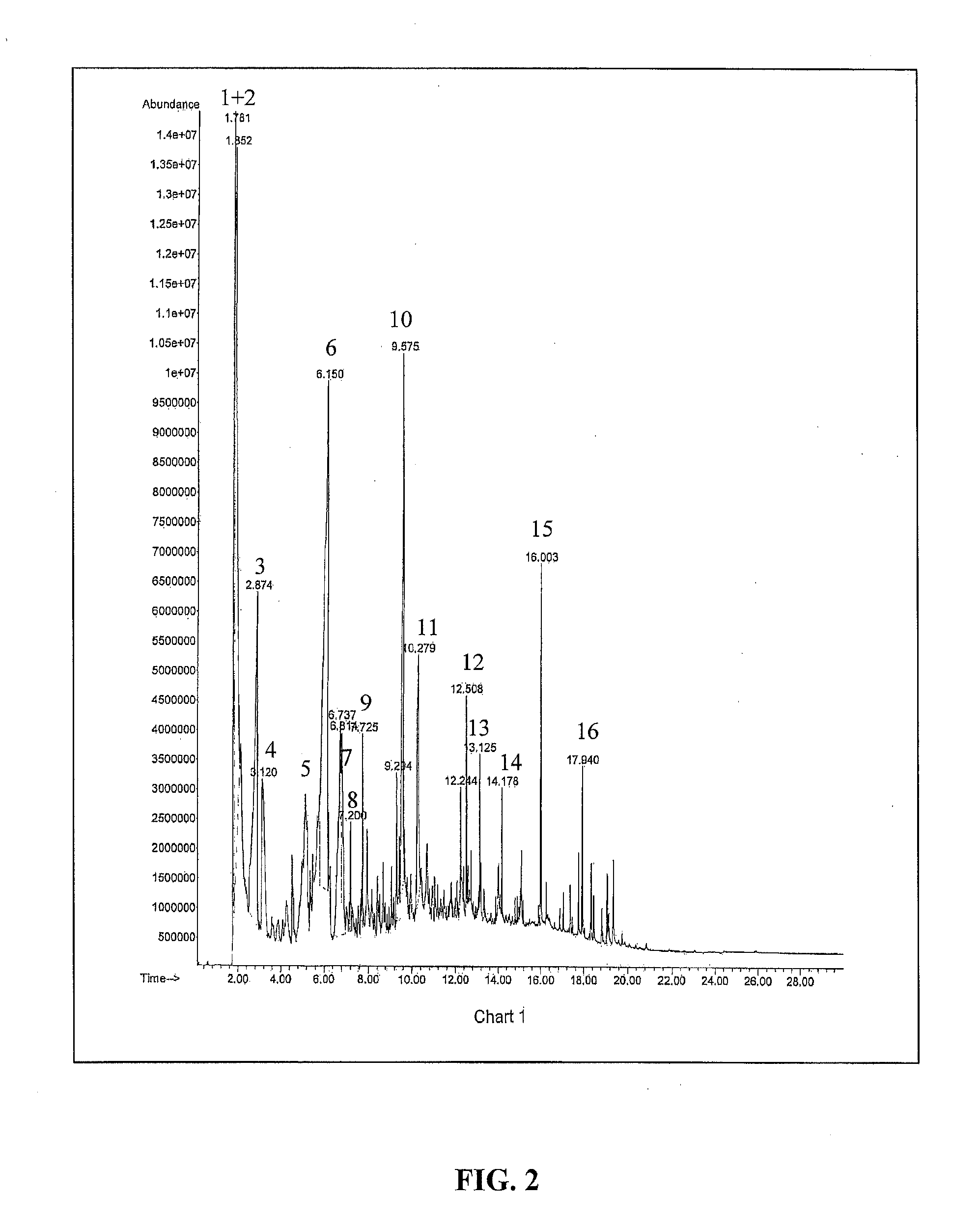Process For Producing A Monomer Component From A Genetically Modified Polyhydroxyalkanoate Biomass
- Summary
- Abstract
- Description
- Claims
- Application Information
AI Technical Summary
Benefits of technology
Problems solved by technology
Method used
Image
Examples
example 1
Generation of Biobased Crotonic Acid from Pyrolysis of Genetically Engineered Tobacco Expressing Poly-3-hydroxybutyrate
[0158]In this example, it is shown that heating of genetically engineered plant biomass containing poly-3HB generates biobased crotonic acid monomer. Tobacco was genetically engineered to express poly-3HB and cultivated under greenhouse conditions yielding plant biomass containing 10% poly-3HB on a dry leaf basis. Tobacco leaves were removed from their plants, dried to 2 95%+Sigma Aldrich) and dried at 110° C. in an oven prior to being subject to Py-GC-MS at 350° C. The final concentration of lime in the dry tobacco biomass was 5% by weight. FIGS. 2 and 3 show the Py-GC-MS plots for the Tobacco without lime and with lime catalyst while Tables 1 and 2 list the chromatogram peak retention times and mass spectral library matches. The results show that at 350° C., the major compounds generated by heating the Tobacco with 10% poly-3HB were CO2, acetic acid and crotonic a...
example 2
Lignocellulosic Hydrolysis Followed by Generation of Biobased Crotonic Acid from Pyrolysis of Genetically Engineered Tobacco Expressing Poly-3-hydroxybutyrate
[0159]In this example, a process is described where plant biomass containing poly-3HB is first processed to remove soluble sugars and other components and then heated to generate biobased crotonic acid. Tobacco engineered to express poly-3HB at 10% by wt. in the leaf plant was harvested after growing to full size in a greenhouse. A total of 100 g of dried tobacco leaves containing about 10 g of PHA was collected and milled to Microbial Polyesters, John Wiley& Sons, 1990, p24) indicating a total PHA content of about 8 g (80% recovery of PHA). This dried residue was subjected to pyrolysis GC at 350° C. yielding crotonic acid at recovery of 90% and purity of >95% (cis and trans combined).
example 3
Generation of Biobased Acrylic Acid Ester from the Pyrolysis of a Genetically Engineered Biomass Producing Poly-3-hydroxybutyrate Followed by Crotonic Acid Metathesis
[0160]In the previous example, it was shown how biomass+poly-3HB could be used to generate biobased crotonic acid by heating to temperatures where thermal decomposition of poly-3HB is initiated. Crotonic acid recovered from this process could be further transformed into valuable chemical intermediates by using cross metathesis reactions. This example details a method for converting crotonic acid to acrylic acid esters using a multiple tandem catalyst process.
[0161]Cross metathesis is the coupling of two reactants containing unsaturated carbon bonds and has been historically limited to starting compounds that do not have any functional groups such as simple olefins (ethylene, propylene etc.). The ruthenium-based organic catalysts which are now being manufactured by Materia (U.S. Pat. Nos. 6,620,955 and 7,026,495) and dev...
PUM
| Property | Measurement | Unit |
|---|---|---|
| Temperature | aaaaa | aaaaa |
| Temperature | aaaaa | aaaaa |
| Temperature | aaaaa | aaaaa |
Abstract
Description
Claims
Application Information
 Login to View More
Login to View More - R&D
- Intellectual Property
- Life Sciences
- Materials
- Tech Scout
- Unparalleled Data Quality
- Higher Quality Content
- 60% Fewer Hallucinations
Browse by: Latest US Patents, China's latest patents, Technical Efficacy Thesaurus, Application Domain, Technology Topic, Popular Technical Reports.
© 2025 PatSnap. All rights reserved.Legal|Privacy policy|Modern Slavery Act Transparency Statement|Sitemap|About US| Contact US: help@patsnap.com



